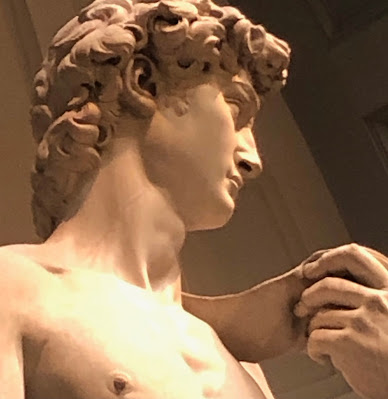Annamaria on Monday
I am not the only one. Just last month, I took my friends Diane and William to see David for their first time. Having walked around it once, William said, "It's worth it to fly here from New York, just to see this!" Yup!
Today, I want to weigh in on an open question about that beloved statue. It is stated in a plaque on the wall of the rotunda where the statue stands: scholars disagree on whether Michelangelo has portrayed David before or after his battle with Goliath.
I have no credentials as an art historian. I have not even read the literature on this question. But I think I know the answer. At the very least, I think I can put up a good argument. So I am sharing it with you today.
All three of Italy's greatest sculptors – Michelangelo, Donatello, and Bernini have sculpted statues of David. The subject was a favorite with that family of great art supporters, the Medici. The story of a boy who wins a battle against an overwhelmingly more powerful enemy appealed to the rulers of Florence, who were then just a few generations from upstart-hood.
All three portrayals of David are splendid. There is no question about that. And almost no one disagrees that Michaelangelo's is the greatest.
With the other two there is no question about when in the story they are portraying the quintessential biblical hero.
Bernini caught David in the act:
Donatello, in his greatest work, shows us David after he has vanquished Goliath. You can't mistake that, especially since the boy in the statue has his foot on the giant's severed head.
I don't get why there is an argument about Michelangelo's David. To me, even at first glance, it seems that he is portrayed before the battle. He is holding the sling with his left hand. It hangs down over his shoulder.
In his right hand is the rock that he intends to sling at the giant.
You would think that would end of the argument. But it hasn't.
Donatello's victorious David is still holding a rock. I'm not sure why, but if Donatello's David could be still be holding a rock after the battle, why shouldn't Michelangelo's? On the other hand, Donatello's David has cast off his sling, which is lying behind his right foot.
I think the fact that Michelangelo's David is still holding the sling is a fact supporting my point of view.
But there is more powerful evidence.
Let's look at the expressions on the faces of these boys. In no way could we mistake what Bernini's David is feeling and thinking. He's taking his best shot, with all his might.
And Donatello's is at peace. He has nothing more to worry about. He has thrown down his sling and taken up his sword. His enemy is literally under his foot.
It has always been the expression on Michaelangelo's David's face that has convinced me. And filled me with awe. It is convincing because it portrays all three of the emotions one would expect in a young shepherd about to do battle with a formidable foe twice his size. Astonishing as it may seem, as one walks around and views David's face at different angles, one sees all these expressions.
In the full profile, you see the face the of a young warrior contemplating his strategy.
At forty-five degrees, you see - in the set of his jaw and in his eyes and his knitted brow - that he is gathering his courage.
Face on, you see his fear.
These are emotions powerfully portrayed in a face carved in stone!
Certainly, the art historians can see this too. Yet, influential ones cling to the notion that they are looking at David after the battle.
Here is where I, the historical novelist, take more than the stone into account. All we know of Michelangelo tells us that he was aspirational. It's in his letters, his poetry, and his actions. He was an artist constantly striving to outdo himself. He fought against anyone who tried to limit him, even if that person was the Pope who wanted his own way when it came to the ceiling he was paying Michelangelo to paint. What aspect of David would such an artist want to sculpt? One satisfied with his achievement? Or one determined to win, no matter what?
I think I know.






























I'm totally convinced!
ReplyDeleteHurrah! You know, Michael, that you have a standing invitation to visit. Then you can see for yourself!
DeleteBravissima, AmA! Complimenti! Un lavoro ben fatto! Grande!
ReplyDeleteMille grazie, EvKa, amico mio. Piacere mio!
ReplyDeleteGreat blog, Annamaria! Was it you who told me that the reason certain parts of such statues are portrayed slightly ahem, smaller than in real life, was because it was supposed to show the intellect winning out over more physical pursuits?
ReplyDeleteIt wasn’t me, Zoe. It is an interesting idea, since that part of the anatomy might be more a focus of attention otherwise. I sometimes comment, depending on who I am with on a particular visit, that no one seems to notice that he isn’t Jewish.
DeleteThat's a very convincing analysis, Sis. What I remember most about the first time I saw David was thinking at any moment he could step down and walk out of the Galleria dell'Accademia to the surprise of no one.
ReplyDeleteSo right, Bro. Out mutual friend, Lenny Kleinfeld sent a comment saying that, more than any other sculpture he has seen, this one seems to portray a living person.
Delete